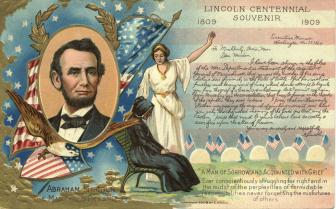 The
Nash Postcard Company of Ohio, known for their Civil War themes and
illustrations, produced a set specifically for the Lincoln Centennial in
1908, a year early. The
example in figure 4, left, shows a mythological character comforting
a grieving woman who sits near a row of five tombstones, each decorated
with a pair of national flags. Lincoln’s
portrait appears to the left, surrounded by the familiar laurel leaves,
eagle, and patriotic motifs. To
the right, below the series title, is a letter of condolence written by
Lincoln to a Mrs. Bixby of Boston on the loss of five sons to combat. The
Nash Postcard Company of Ohio, known for their Civil War themes and
illustrations, produced a set specifically for the Lincoln Centennial in
1908, a year early. The
example in figure 4, left, shows a mythological character comforting
a grieving woman who sits near a row of five tombstones, each decorated
with a pair of national flags. Lincoln’s
portrait appears to the left, surrounded by the familiar laurel leaves,
eagle, and patriotic motifs. To
the right, below the series title, is a letter of condolence written by
Lincoln to a Mrs. Bixby of Boston on the loss of five sons to combat.
That letter, sent in care of Massachusetts
Adjutant General William Schouler to be delivered personally to the
grieving mother, was first copied by Schouler and released to the Boston
newspapers, from which it was reprinted nationwide.
Its raw anguish and sincere gratitude comforted a nation mourning
the loss of sons, sweethearts and fathers.
The president is not depicted as a part of the
mourning scene, but overlooks his words and the black-clad woman as a
figure of mythic proportions in his own right. This tone is echoed throughout the series as “The Martyred
President” becomes a part of American mythology, enshrined in the
American psyche.
Of Mrs. Bixby’s five sons sacrificed “upon the
alter of freedom,” three turned up later very much alive, only
temporarily lost in the fog of war and reported killed.
Charles and Oliver did die in combat, but Henry was captured at
Gettysburg and later exchanged, George was captured and joined the
southern forces, and Edward, only sixteen years old, deserted and went to
sea. The image of five
fraternal tombstones, however, persists on the postcard as a fundamental
bit of national Lincoln folklore.
Artistic renditions of Abraham Lincoln during his
lifetime ranged from cartoonish political drawings to somber photographic
likenesses. Immediately after
his assassination, however, those images became idealistic and noble.
Within a decade, the images began to take on mythic qualities. Lincoln was never elevated to the stature of a god, as was George
Washington in Constantino Brumidi’s The Apotheosis of Washington, which
was installed on the rotunda of the capitol in 1865, nor even to colossus,
as Horatio Greenough sculpted the founding father. Lincoln remained, even in allegorical reverence, a man of the
people.
 Lincoln
the Liberator is
one of the great recurring mythological themes in Lincoln postcards.
In the Nash version (figure 5, right), he appears before a kneeling
slave family, bidding them to rise from their lowly condition. Although chains still encircle their limbs, a cast-off chain lies
conspicuously at the president’s feet, and he holds a rolled up
document, the Emancipation Proclamation. Lincoln
the Liberator is
one of the great recurring mythological themes in Lincoln postcards.
In the Nash version (figure 5, right), he appears before a kneeling
slave family, bidding them to rise from their lowly condition. Although chains still encircle their limbs, a cast-off chain lies
conspicuously at the president’s feet, and he holds a rolled up
document, the Emancipation Proclamation.
Previous
Page | Next Page |
